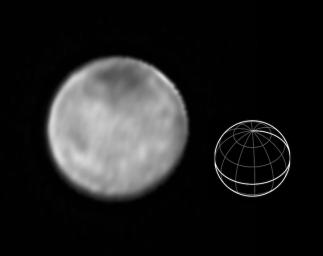
|
Bright Spots on Charon
- Click the image above for a larger view
- Full-Res JPEG (724 x 574) (16.7 kB)
- Full-Res TIFF (724 x 574) (416.2 kB)
Caption:
This image of Charon was taken by New Horizons' Long Range Reconnaissance Imager (LORRI) at 4:23 UT on July 9, 2015, from a range of 3.9 million miles (6.3 million kilometers). It reveals fascinating detail, never before seen, on the surface of Pluto's giant moon, which has a diameter of 750 miles (1208 kilometers). The dark north polar region, which has been seen for several weeks on approach, is still prominent, but numerous bright spots, scattered over Charon's surface, are now also visible. It is possible that many of these spots are bright icy material excavated from Charon's subsurface by impact craters, but whether this is true will become clearer in the next few days.
Three consecutive images were combined and sharpened, using a process called deconvolution, to create this view. Deconvolution enhances real detail but can also generate spurious features, including the bright margin seen on the upper edge of the disk.
The wireframe globe shows the orientation of Charon in the image -- thicker lines indicate the equator and the prime meridian (the direction facing Pluto). Central longitude on Charon is 266°.
Background Info:
The Johns Hopkins University Applied Physics Laboratory in Laurel, Maryland, designed, built, and operates the New Horizons spacecraft, and manages the mission for NASA's Science Mission Directorate. The Southwest Research Institute, based in San Antonio, leads the science team, payload operations and encounter science planning. New Horizons is part of the New Frontiers Program managed by NASA's Marshall Space Flight Center in Huntsville, Alabama.
Cataloging Keywords:
| Name | Value | Additional Values |
|---|---|---|
| Target | Charon | Pluto |
| System | Pluto | Kuiper Belt |
| Target Type | Satellite | Dwarf Planet, KBO |
| Mission | New Horizons | |
| Instrument Host | New Horizons | |
| Host Type | Flyby Spacecraft | |
| Instrument | Long Range Reconnaissance Imager (LORRI) | |
| Detector | ||
| Extra Keywords | Crater, Grayscale, Impact, Visual | |
| Acquisition Date | ||
| Release Date | 2015-07-10 | |
| Date in Caption | 2015-07-09 | |
| Image Credit | NASA/Johns Hopkins University Applied Physics Laboratory/Southwest Research Institute | |
| Source | photojournal.jpl.nasa.gov/catalog/PIA19704 | |
| Identifier | PIA19704 | |
